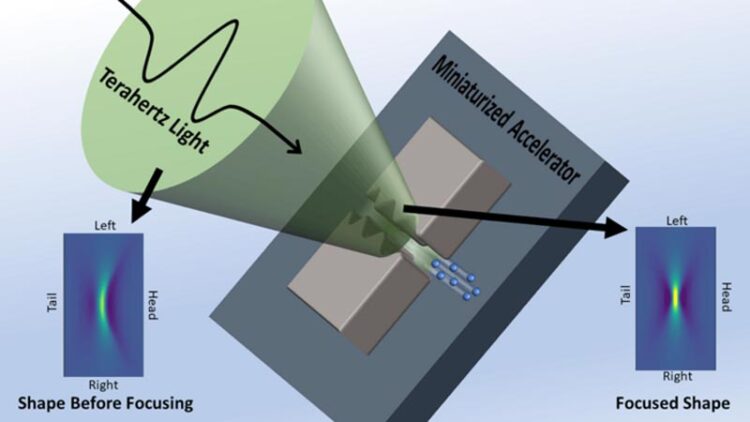Sizing up special light to downsize particle accelerators

A pulse of terahertz light is focused (green) on a miniaturized particle accelerator to give energy to particles (blue spheres). New technology measures how the shape of the terahertz pulse (inset images) changes as it is focused on its target.
Image courtesy of Oak Ridge National Laboratory
Measuring the shape of intense bursts of terahertz light paves the way for future accelerator technologies.
The Science
Researchers have developed a new technique to better measure special “terahertz” light. This light travels in waves longer than the infrared light that is beyond what the human eye perceives. The new sampling technique preserves the correlations between position and time in a pulse of terahertz light. The technique allows researchers to measure the shape of terahertz “light bullets,” focused flashes of light that are as wide as they are long. This helps researchers learn how they can use terahertz pulses to improve particle accelerators. Particle accelerators help scientists examine new materials, proteins, and even the building blocks of our universe, and improved accelerators would help advance industry, medicine, and scientific research.
The Impact
Modern particle accelerator facilities can be huge. Terahertz technology may offer a path to miniaturize them. For example, the proton accelerator at the Spallation Neutron Source, a Department of Energy user facility, is three football fields long. Using terahertz light, particles could reach the same energy in less than the length of an end zone. Such miniaturization could help facilities reach higher energies for new scientific discoveries. This will require scientists to learn more about the characteristics and behavior of terahertz light. This new measurement technique will help to make these smaller future accelerators possible.
Summary
Scientists at Oak Ridge National Laboratory, home of the Spallation Neutron Source user facility, are investigating how to produce and use terahertz light to enable particle accelerators using terahertz technology. Making terahertz light bullets with intense lasers is a promising method because the terahertz energy is strongly concentrated, creating very high accelerating fields. By developing a new measurement technique, researchers have discovered that when focused onto its target, this terahertz light will change its shape, possibly affecting particle accelerator performance.
The terahertz light bullets change shape because they are made up of many terahertz frequencies, similar to how white light is made of different visible frequencies or colors. Just like the colors of white light can separate to make a rainbow, the colors of this terahertz light can separate from each other when focused on a target. If not accounted for, this separation leads to imperfections in the shape of the light and makes it less concentrated which could result in weaker particle acceleration. However, using this new electro-optic sampling method in combination with modeling tools, these imperfections can be measured and used in the design of new optics to correct the terahertz shape. With a clever optic design, it may even be possible to improve the terahertz shape and enhance particle acceleration.
Funding
This research was performed at the Spallation Neutron Source, a Department of Energy Office of Science user facility operated by the Oak Ridge National Laboratory.
Media Contact
Michael Church
DOE/US Department of Energy
michael.church@science.doe.gov
Office: 2028416299
https://www.energy.gov/science/bes/articles/sizing-special-light-downsize-particle-accelerators
All latest news from the category: Physics and Astronomy
This area deals with the fundamental laws and building blocks of nature and how they interact, the properties and the behavior of matter, and research into space and time and their structures.
innovations-report provides in-depth reports and articles on subjects such as astrophysics, laser technologies, nuclear, quantum, particle and solid-state physics, nanotechnologies, planetary research and findings (Mars, Venus) and developments related to the Hubble Telescope.
Newest articles

Innovative 3D printed scaffolds offer new hope for bone healing
Researchers at the Institute for Bioengineering of Catalonia have developed novel 3D printed PLA-CaP scaffolds that promote blood vessel formation, ensuring better healing and regeneration of bone tissue. Bone is…

The surprising role of gut infection in Alzheimer’s disease
ASU- and Banner Alzheimer’s Institute-led study implicates link between a common virus and the disease, which travels from the gut to the brain and may be a target for antiviral…

Molecular gardening: New enzymes discovered for protein modification pruning
How deubiquitinases USP53 and USP54 cleave long polyubiquitin chains and how the former is linked to liver disease in children. Deubiquitinases (DUBs) are enzymes used by cells to trim protein…


